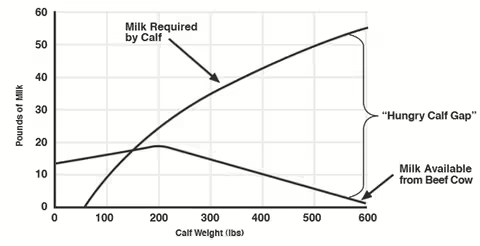
Creep Feeding
Consider the pros and cons of creep feeding.
Increasing profit is the ultimate goal of any business, and the cattle business is no exception. In effort to maximize profit, producers have to focus on producing the greatest amount of premium product without sacrificing production efficiency. The ability to produce more pounds of a high quality product results in more income for the producer. Realizing the cow can only provide nutrition to the calf at a certain level, creep feeding can offer additional nutrition to maximize growth and weaning weights. This additional weight looks to be quite valuable in the current and future market.
Why Creep Feed
Increases in weaning weight are related to the lactation curve seen in beef cows. In most studies, peak milk production occurs around 60 days postpartum and then begins to decline there forth. In contrast, the calf is growing in size and weight. This results in a need for nutrition other than milk to reach maximum performance. In spring calving systems, forage quality is also declining, thus creep feed is offered to fill the gap.
Researchers at the University of Illinois have traditionally been leaders in creep feeding research and continue to look at new options in calf nutrition and management. For years producers have known that creep feeding will add additional pounds and result in heavier weaning weights. We also know that heifers that are creep-fed will likely exhibit lower milk production as producing beef cows. The following list summarizes research results into pros and cons. (At right: “Creep Feeding Beef Calves.” Dan Eversole. Virginia Cooperative Extension)
Benefits of creep feeding
- Increased weaning weight
- Calves are bunk broke at weaning
- Easier transition and less stress at weaning
- Adds bloom/condition to sale calves
- Compensates for low milking cows
- Corn creep feeds or high-fat co-product creep feeds can initiate marbling and improve carcass quality
- Can reduce calf competition for pasture with cows
Negative effect of creep feeding
- Economics depend on the year
- Lowers future milk production of replacement heifers
- Loss of compensatory gain at weaning
- Can produce fleshy calves that receive price discount
- Labor needed to fill feeders, mix feed, etc.
- Corn creep can cause neg. associative effects and reduce fiber digestion
What the research tells us about starch-based vs. fiber-based diets.
The use of starch-based (corn) or fiber-based feeds (grass, hay, CGF, soyhulls, DDGS) has been a debated topic. Researchers at University of Illinois have been focusing efforts to better describe the differences in starch-based creep feeds vs. fiber-based creep feeds.
- Obviously, starch-based feeds can have negative effects on fiber digestion which would diminish the contribution of the pasture grass calves consume. However, research shows that starch-based feeds have the ability to shift the acetate: propionate ratio and illicit more deposition of marbling in young beef calves. Thus, there are advantages in subsequent carcass quality when feeding starch-based feeds to young calves.
- Feeding fiber-based feeds like CGF, soyhulls, grass, or hay have been beneficial effects in maintaining fiber digestion efficiency. These feeds are able to fill the “hungry calf gap” and support higher weight gain while on the cow. However, these feeds are not effective in initiating marbling in calves.
Most recent research at Illinois has investigated creep feeds containing higher fat co-products (similar to DDGS). In this research, calves on fiber-based diets had similar performance to those on starch-based diets. The cattle were fed the same diet in the finishing phase to allow evaluation of the differences in the calf phase. The results showed no difference in feedlot performance or carcass traits.
This suggests that higher fat levels seen in co-products similar to DDGS are able to cause initiation of marbling similar to corn-based diets. Thus, it is important to evaluate the nutrient analysis of co-products and understand that differing levels of fat could affect subsequent carcass traits. Other mechanisms, like sulfur content and pH, could be playing a role in this outcome.
Bottom-line, feeding higher-fat co-products resulted in similar gain and carcass traits as starch-based feeds, thus economics should drive your decision on which feed to utilize.
Creep Feeding Economics
Ultimately, cost and return on investment is the deciding factor in creep feeding. Feed conversion and feed cost play major roles in deciding if creep feeding will be profitable. Feed conversion can range widely, but 10:1 is a good number to use for a high concentrate creep-feed. The chart at the bottom of the page should help illustrate the potential profits from creep feeding.
At feeder calf prices of $178/cwt, creep feeding looks to be profitable in most cases. This table is a feed only cost evaluation, thus all producers should look at the costs they incur to deploy creep feeding.
Feed cost ($/ cwt)
| Feed/pound extra gain | Feed cost ($/ cwt) | |||||
|---|---|---|---|---|---|---|
| 10 | 11 | 12 | 13 | 14 | 15 | |
| 6 | 60 | 66 | 72 | 78 | 84 | 90 |
| 8 | 80 | 88 | 96 | 102 | 110 | 118 |
| 10 | 100 | 110 | 120 | 130 | 140 | 150 |
| 12 | 120 | 132 | 144 | 156 | 168 | 180 |
| 14 | 140 | 154 | 168 | 182 | 196 | 210 |
It makes sense.
Creep feeding is a management strategy to allow calves to perform at higher levels when milk production and forage resources cannot support additional gain requirements. Creep feeding has advantages and disadvantages that need to be looked at on an individual farm basis. The source of feed used can result in differences in carcass quality traits. Thus, marketing goals should be considered when choosing what feed ingredients make up the best creep feed for your operation. With calf prices at record levels, any management strategy that can increase pounds at selling will look good. Be sure to put the pencil to the paper and look for the best return on your investment.
About the author

